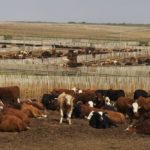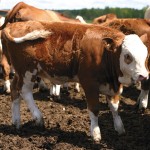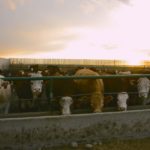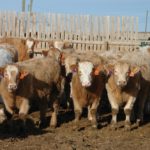Compared to last week, western Canadian feeder cattle markets traded $4-$6 higher. Yearlings led the charge higher with quality packages selling $5 to as much as $8 above week-ago levels. The return of seasonal temperatures provided a shot of adrenaline for the feeder market. There are quite a few operations carrying minimal numbers because of […] Read more

Klassen: Spring weather revitalizes feeder market

Klassen: Feeder market stabilizes
Compared to last week, western Canadian feeder cattle prices were relatively unchanged. Stronger export demand appears to be supporting the market in Manitoba and certain pockets in Saskatchewan; however, Alberta feedlot interest remains subdued. Adverse weather continues to plague southern Alberta. Snow and freezing temperatures followed by brief melting periods have resulted in very poor […] Read more

Calf market will feel the pinch come fall
Market Update: It will take time to work burdensome beef supplies through the U.S. system
Alberta fed cattle prices have traded in the range of $162 to $166 throughout February and March, but the market is poised to grind lower during the second quarter due to the large year-over-year increase in second-quarter beef production. Fed cattle are poised for a $15 to $20 drop over the next couple of months […] Read more

Klassen: Feeder market continues lower trend
Western Canadian feeder cattle markets traded $5 to $8 below week-ago levels; noticeable declines were noted in the lighter weight categories, which were down $6 to as much as $10. Adverse weather continues to plague the feedlot regions of Alberta and Saskatchewan. Another snowfall over the weekend caused pen conditions to erode to lowest levels […] Read more

Klassen: Rising feed grain prices weigh on feeder market
Western Canadian yearling prices were relatively unchanged from week-ago levels; however, feeder cattle fit for grass and calves dropped $4 to as much as $10 from seven days earlier. Rising feed grain costs appear to be affecting lighter weight categories more than the yearling market. Feedlots will be struggling with negative margins through the summer […] Read more

Other indicators affecting cattle market decisions
Risk Management Part 4: Who’s using the futures market and what are their intentions?
In my previous article, I discussed four possible market environments and the possible marketing or hedging strategies for each environment. Cow-calf producers will know if the basis is weak or strong based on longer-term historical data. The price range of the futures market over the past two years will provide a good idea if the futures market is in […] Read more

Klassen: Feedlots struggle through adverse weather
Western Canadian yearling prices experienced a week-over-week decline of $5-$8 with some pockets deteriorating $10 to as much as $12. Adverse weather in southern Alberta has resulted in limited buying interest from main feedlot operators. Feedlot Alley has received 150-200 per cent of normal precipitation over the past 60 days. Snow and rain, along with […] Read more

Klassen: Buyers’ temperance subdues feeder market
Compared to last week, western Canadian yearling prices were under pressure trading steady to $3 lower; however, eastern Canadian orders were prevalent in Manitoba and eastern Saskatchewan, where values were relatively unchanged from week-ago levels. Alberta feedlot demand was subdued as the deferred live cattle futures traded to three-month lows. Most operations are holding high-priced […] Read more

To sell or background calves?
Risk Management Part 3: The futures and basis will guide key decisions
This is the third article on price risk management for feeder cattle. In the first article, I provided a review of using the average basis to project an expected forward price for 550-pound steer calves and 850-pound yearlings. In the second article, I answered some common questions from producers. I showed producers should factor in […] Read more
Klassen: Feeder market sends mixed signals
Compared to last week, western Canadian average yearling prices were steady to $3 lower while heavier replacements above 1,000 lbs. actively traded $3 to as much as $6 lower. Weakness in deferred live cattle futures, along with rising feed grain prices, caused buyers to lower their bids accordingly. Steers averaging 1,000 lbs. were readily trading […] Read more


